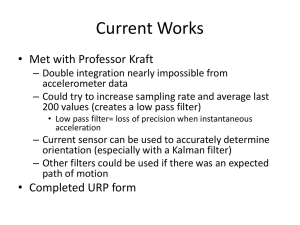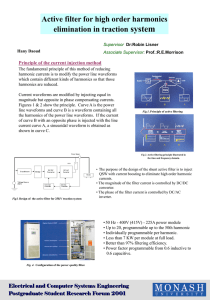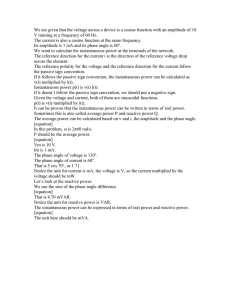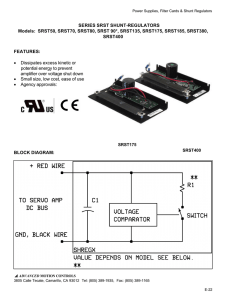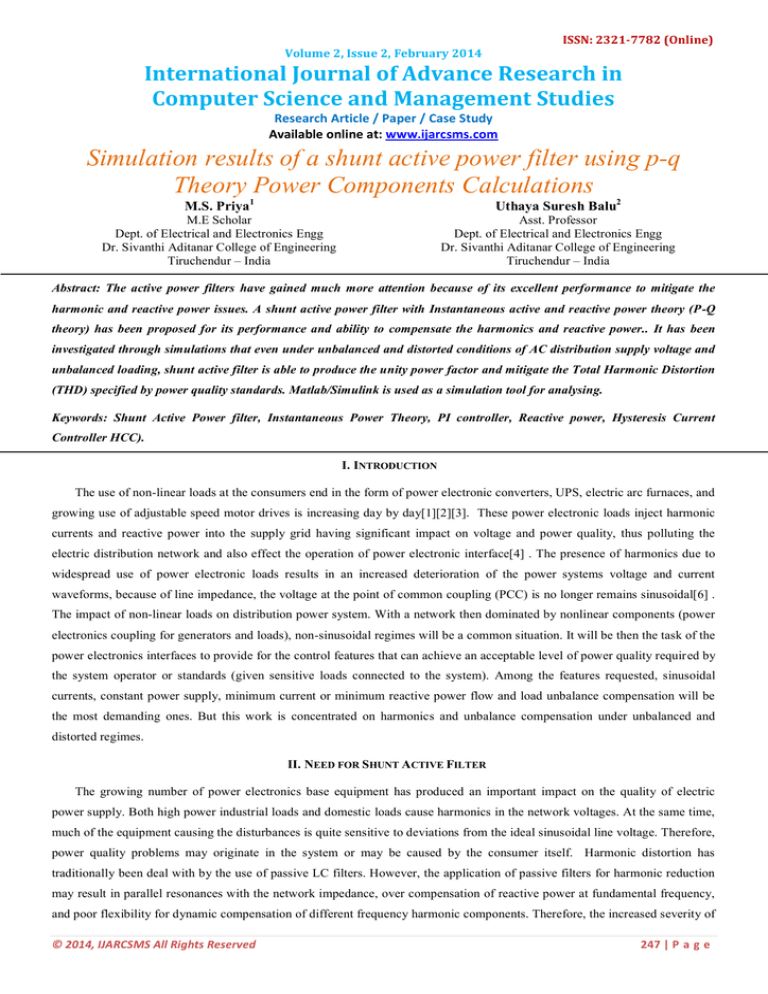
ISSN: 2321-7782 (Online)
Volume 2, Issue 2, February 2014
International Journal of Advance Research in
Computer Science and Management Studies
Research Article / Paper / Case Study
Available online at: www.ijarcsms.com
Simulation results of a shunt active power filter using p-q
Theory Power Components Calculations
M.S. Priya1
Uthaya Suresh Balu2
M.E Scholar
Dept. of Electrical and Electronics Engg
Dr. Sivanthi Aditanar College of Engineering
Tiruchendur – India
Asst. Professor
Dept. of Electrical and Electronics Engg
Dr. Sivanthi Aditanar College of Engineering
Tiruchendur – India
Abstract: The active power filters have gained much more attention because of its excellent performance to mitigate the
harmonic and reactive power issues. A shunt active power filter with Instantaneous active and reactive power theory (P-Q
theory) has been proposed for its performance and ability to compensate the harmonics and reactive power.. It has been
investigated through simulations that even under unbalanced and distorted conditions of AC distribution supply voltage and
unbalanced loading, shunt active filter is able to produce the unity power factor and mitigate the Total Harmonic Distortion
(THD) specified by power quality standards. Matlab/Simulink is used as a simulation tool for analysing.
Keywords: Shunt Active Power filter, Instantaneous Power Theory, PI controller, Reactive power, Hysteresis Current
Controller HCC).
I. INTRODUCTION
The use of non-linear loads at the consumers end in the form of power electronic converters, UPS, electric arc furnaces, and
growing use of adjustable speed motor drives is increasing day by day[1][2][3]. These power electronic loads inject harmonic
currents and reactive power into the supply grid having significant impact on voltage and power quality, thus polluting the
electric distribution network and also effect the operation of power electronic interface[4] . The presence of harmonics due to
widespread use of power electronic loads results in an increased deterioration of the power systems voltage and current
waveforms, because of line impedance, the voltage at the point of common coupling (PCC) is no longer remains sinusoidal[6] .
The impact of non-linear loads on distribution power system. With a network then dominated by nonlinear components (power
electronics coupling for generators and loads), non-sinusoidal regimes will be a common situation. It will be then the task of the
power electronics interfaces to provide for the control features that can achieve an acceptable level of power quality required by
the system operator or standards (given sensitive loads connected to the system). Among the features requested, sinusoidal
currents, constant power supply, minimum current or minimum reactive power flow and load unbalance compensation will be
the most demanding ones. But this work is concentrated on harmonics and unbalance compensation under unbalanced and
distorted regimes.
II. NEED FOR SHUNT ACTIVE FILTER
The growing number of power electronics base equipment has produced an important impact on the quality of electric
power supply. Both high power industrial loads and domestic loads cause harmonics in the network voltages. At the same time,
much of the equipment causing the disturbances is quite sensitive to deviations from the ideal sinusoidal line voltage. Therefore,
power quality problems may originate in the system or may be caused by the consumer itself. Harmonic distortion has
traditionally been deal with by the use of passive LC filters. However, the application of passive filters for harmonic reduction
may result in parallel resonances with the network impedance, over compensation of reactive power at fundamental frequency,
and poor flexibility for dynamic compensation of different frequency harmonic components. Therefore, the increased severity of
© 2014, IJARCSMS All Rights Reserved
247 | P a g e
Priya et al.,
International Journal of Advance Research in Computer Science and Management Studies
Volume 2, Issue 2, February 2014 pg. 247-254
power quality in power networks demands for the development of dynamic and adjustable solutions to the power quality
problems. Switching compensators called Active filters or active power line conditioners provide an effective alternative to the
conventional passive LC filers. They are able to compensate current and voltage harmonics and reactive power, regulate
terminal voltage, suppress flicker, and improve voltage balance in three phase systems. The advantage of active filtering is that
it automatically adapts to changes in the network and load fluctuations.
III. SHUNT ACTIVE FILTER WITH CONTROLLER BASED ON INSTANTANEOUS P-Q THEORY
The concept of Shunt Active Filtering was first introduced by Gyugyi and Strycula in 1976 [6]. Nowadays, a Shunt Active
Filter is not a dream but a reality, and many SAFs are in commercial operation all over the world. The controllers of the Active
Filters determine in real time the compensating current reference, and force the power converter to synthesize it accurately. In
this way, the Active Filtering can be selective and adaptive. In other words, a Shunt Active Filter can compensate only for the
harmonic current of a selected nonlinear load, and can continuously track changes in its harmonic content. The Instantaneous
active and reactive power theory or simply the p-q theory is based on a set of instantaneous values of active and reactive powers
defined in the time domain. There are no restrictions on the voltage or current waveforms, and it can be applied to three-phase
systems with or without a neutral wire for three-phase generic voltage and current waveforms. Thus, it is valid not only in the
steady state, but also in the transient state [16]. This theory is very efficient and flexible in designing controllers for power
conditioners based on power electronics devices. Other traditional concepts of power are characterized by treating a three-phase
system as three single-phase circuits. The p-q Theory first uses Clarke transformation to transforms voltages and currents from
the abc to αβ0 coordinates, and then defines instantaneous power on these coordinates. Hence, this theory always considers the
three-phase system as a unit, not a superposition or sum of three single-phase circuits [16].
A. THE CLARKE TRANSFORMATION
The αβ0 transformation or the Clarke transformation converts the three-phase instantaneous voltages in the abc phases, va,
vb and vc into the instantaneous
voltages on the αβ0 axes v0, vα, and vβ. The Clarke Transformation of three-phase generic
voltages is given by:
(3.1)
and its inverse transformation:
(3.2)
Similarly, three-phase generic instantaneous line currents, ia, ib, and ic, can be transformed on the αβ0 axes by:
(3.3)
and its inverse transformation:
© 2014, IJARCSMS All Rights Reserved
ISSN: 2321-7782 (Online)
248 | P a g e
Priya et al.,
International Journal of Advance Research in Computer Science and Management Studies
Volume 2, Issue 2, February 2014 pg. 247-254
(3.4)
The advantage of using the αβ0 transformation is to separate zero-sequence components from the abc-phase component
since α and β axes make no contribution to zero-sequence components.
(3.5)
and its inverse transformation:
(3.6)
Similar equations hold for the line currents. The transformation of equation (3.5) & (3.6) can also be shown in Figure
3.4.The instantaneous values of phase voltages and line currents referred to the abc stationary axes are transformed into the αβ0
stationary axes, or vice-versa. They are stationary axes and should not be confused with the concepts of voltage or current
phasors. The, b, and c axes are spatially shifted by 120° from each other while the α and β axes are orthogonal, and the α axis is
parallel to the a axis. The direction of the β axis is chosen in such a way that if voltage or current spatial vectors on the abc
coordinates rotate in the abc sequence, they would rotate in the αβ sequence on the αβ coordinates.
Fig. .1- Graphical Representation of Clarke Transformation
B. THE INSTANTANEOUS P-Q THEORY IN THREE-PHASE THREE WIRE SYSTEMS
The Clarke Transformation and its inverse transformation are power invariant and this property is very helpful when
dealing with the analysis of instantaneous power in three phase systems.
The three phase instantaneous active power is given by:
If current and voltages from αβ variables are replaced to their equivalent abc variables then the instantaneous imaginary
power will be:
Let us consider a three phase system with voltages va, vb, and vc are the instantaneous phase voltages and ia, ib, and ic the
instantaneous line currents. Since zero sequence power in threephase three wire system is always zero .According to p-q theory
real and reactive powers can be written as:
© 2014, IJARCSMS All Rights Reserved
ISSN: 2321-7782 (Online)
249 | P a g e
Priya et al.,
International Journal of Advance Research in Computer Science and Management Studies
Volume 2, Issue 2, February 2014 pg. 247-254
where
p = The active power for a three phase system with or without neutral conductor in steady state or during transients and it
representing the total instantaneous energy flow per second between source and load.
q = The imaginary power and proportional to the quantity of energy that is being exchanged between the phases of the system. It
does not contribute to energy transfer between source and load at any time.
p0= Active power due to zero sequence components.
p
= Alternating value of the instantaneous real power exchanged between the power source and the load through the a-b-c
coordinates. Since alternating value of the instantaneous real power does not involve any energy transference from the power
source to load, it must be compensated. It is due to harmonic currents.
q
= Alternating value of the instantaneous imaginary power exchanged between system phases and does not imply transfer of
energy between power source and load. Since alternating value of the instantaneous imaginary power is unwanted, it must be
compensated. It is also due to harmonic currents. All these powers are explained in Fig.2
Fig. .2- Concept of different powers which are transferred and exchanged between power source and load [14]
IV. SIMULATION MODELLING
Simulation is very important and powerful tool to reduce development time and study the dynamics of the systems. In this
work MATLAB/SIMULINK is used as a simulation tool to implement the proposed active filter and study the operation of the
active power filter under different operating conditions. The MATLAB/SIMULINK tool is very effective as it offered an
integrated environment between the designed control algorithm and the electrical network models.
Fig.1- Complete diagram of Shunt Active Filter
A. MODELLING OF THE P-Q THEORY
The p-q theory model is modelled and is shown in the Figure 2. The inputs to the p-q controller are the currents form the nonlinear load. The outputs are the three phase reference currents that are send to the PWM current controller where these currents
are compared with the actual currents of the active filter to get the driving pulses of the inverter.
© 2014, IJARCSMS All Rights Reserved
ISSN: 2321-7782 (Online)
250 | P a g e
Priya et al.,
International Journal of Advance Research in Computer Science and Management Studies
Volume 2, Issue 2, February 2014 pg. 247-254
Fig.2- Subsystem of shunt active filter
V. SIMULATION RESULTS
A number of simulations have been performed to check the working of the shunt active power filter under various nonlinear loadings (w.r.t connection of the loads at the PCC) and nonideal supply. The analysis of the results show that the working
of the active filter is very satisfied to compensate the harmonics and reactive power even under unbalanced and distorted
conditions of distribution supply
Fig.1- source current without SAF
Fig.1 shows source current without shunt active filter. Due to the presence of the non linear load, so the current waveform is in
distorted manner. The current is taken along the Y-axis and time is taken along the X-axis.
Fig.2- Iref current
Fig.2 shows Iref current which is simulated using MATLAB. By inverse Clarke transformation Iref current is calculated
and in order to generate the gate pulse.
Fig.3- Source current with SAF
© 2014, IJARCSMS All Rights Reserved
ISSN: 2321-7782 (Online)
251 | P a g e
Priya et al.,
International Journal of Advance Research in Computer Science and Management Studies
Volume 2, Issue 2, February 2014 pg. 247-254
Fig.3 shows the sinusoidal waveform of the source current due to the implementation of the shunt active filter. The
harmonic which gets induced due to the presence of the non linear load gets reduced and forming the nearby sinusoidal current.
Fig.4-Capacitor voltage(Vdc)
Fig.5-Real and Reactive power
The voltage of the capacitor at the voltage source converter, real and reactive power is shown in fig.4&5. The voltage
maintained at the constant value by maintaining a constant voltage at the capacitor side.
Fig.6- THD in source current before SAF
The following fig.6 shows the THD analysis of source current without SAF. THD is found to be 30.28% respectively due to
nonlinear load which creates harmonics in the three phase system the IEEE standard THD value should be less than 2%. Inorder
to reduce the THD the proposed system is implemented
Fig.7- THD in source current after SAF
The following fig.7 shows the THD analysis of source current with SAF. THD is found to be 0.11% respectively.
© 2014, IJARCSMS All Rights Reserved
ISSN: 2321-7782 (Online)
252 | P a g e
Priya et al.,
International Journal of Advance Research in Computer Science and Management Studies
Volume 2, Issue 2, February 2014 pg. 247-254
TABLE.I
COMPARISON OF THD IN SOURCE CURRENT
THD IN SOURCE CURRENT BEFORE SHUNT ACTIVE FILTER
THD IN SOURCE CURRENT AFTER SHUNT ACTIVE FILTER
30.28%
0.11%
VI. CONCLUSION AND SCOPE OF FUTURE WORK
A. Conclusions
The three phase three wire shunt active filter with controller based on instantaneous active and reactive power (p-q) theory
is simulated in MATLAB/SIMULINK to compensate the problems of the harmonics and reactive power which are encountered
from power electronic non-linear loads. The performance of the shunt active power filter is investigated under different
scenarios. It is investigated that the p-q theory based active filter manages to compensate the harmonics and reactive power of
the power distribution network even under unbalanced and distorted supply voltages. The active power filter is able to reduce
the THD in source current at a level well below the defined standards specified by power quality standards. The THD in source
current after the active filtering is not exactly zero. It is because internal switching of the compensator itself generates some
harmonics. In each of the case studied, the source current after the working of the active filter becomes perfectly sinusoidal, free
from harmonics and in-phase with voltage of the main supply maintaining the unity power factor. In each simulation studied,
multiple non-linear loads have been used to investigate the time response of the active filter. In each case it has noted that filter
is successfully able to follow the reference currents with one power cycle with change in loads. It has been noted that if voltage
unbalance or distortion or both are present in the system, the simple p-q theory didn’t work well. It give rise the demand of the
fundamental positive sequence voltage detector to extract the fundamental positive voltage form the unbalanced or distorted
voltage. Once the fundamental positive sequence voltage is extracted, the theory worked very well. Even though the p-q theory
has managed to compensate the harmonics and reactive power of the system and to produce the sinusoidal source current with
unity power factor and free from harmonics.
B. Future Work
The scope of the future work can be to look for the solution of the following points:
This work is based on three phase three wire system and the active filter does not work well if there is a zero sequence
in the supply voltage. In future, a detailed analysis can be carried out for a 3 phase four wire filter in order to
compensate the zero sequence present in the system.
The work done in this thesis can be verified in the laboratory and further experimental study can be done to implement
the APF for the compensation of harmonics and zero sequence.
References
1.
G.Tsengenes, G. Adamidis, “A New Simple Control Strategy for Shunt Active Power Filters under Non Ideal Mains Voltages,” SPEEDAM 2010
International Symposium on Power Electronics, Electrical Drives, Automation and Motion.
2.
Dannana Santosh, Banoth Madhu and Manjeet V Kanojiya, “Instantaneous Active and Reactive Current Component Method for Active Filters under
Balanced & Unbalanced mains Voltage Conditions for 3-ph 3-wire System,” Thesis 2011-2012.
3.
Ahmed M. Mohammad, “Analysis and Simulation of Shunt Active Filter for Harmonic Cancellation of Non Linear Loads”, 03.06.2010.
4.
Elisabetta Tedeschi, “Cooperative Control of Distributed Compensation Systems in Electric Networks Under Non-Sinusoidal Operations” Thesis.
5.
Surajit Chattopadhyay, Madhuchhanda and Mitra Samarjit Sengupta, “Electric Power Quality,” December 2010
6.
Mohd Izhar Bin A Bakar, “Active Power Filter with Automatic Control Circuit for Neutral Current Harmonic Minimization Technique”, june 2007.
7.
N. Mohan, T. Undeland, W. Robbins, “Power Electronics: Converters, Applications, and Design,” J. Wiley & Sons, 2003.
8.
Santoso, Surya and Grady, W. M. Understanding Power System Harmonics. IEEE Power Engineering Review. 2001. 21 (11): 8-11.
© 2014, IJARCSMS All Rights Reserved
ISSN: 2321-7782 (Online)
253 | P a g e
Priya et al.,
9.
International Journal of Advance Research in Computer Science and Management Studies
Volume 2, Issue 2, February 2014 pg. 247-254
Galli, W., Skvarenina, T. L., Chowdhury, B. H. and Akagi, H. Power Quality and Utility Interface Issues. In: Skvarenina, T. L. The Power Electronics
Handbook, United State of America: CRC Press LLC. 2002.
10. David Mark Edward Ingram, “An Evaluation of Harmonic Isolation Techniques for Three Phase Active Filtering,” Master thesis, 1998.
11. Rana Abdul Jabbar Khan, and Muhammad Akmal, “Mathematical Modeling of Current Harmonics Caused by Personal Computers,” World Academy of
Science, Engineering and Technology 39 2008
12. João Afonso, Carlos Couto, Júlio Martins, “Active Filters with Control Based on the p-q Theory”, IEEE Industrial Electronics Society Newsletter Sept.
2000
13. Dinesh Khera, “Simulation of Voltage Source Converter Based Shunt Active Filter in EMTP‐RV,” Master thesis august, 2010
14. Stefan Svensson, “Power measurement techniques for non-sinusoidal conditions,” Doctoral thesis, 1999
15. Shailendra Kumar Jain & Pramod Agarwal, “Design Simulation and Experimental Investigations, on a Shunt Active Power Filter for Harmonics, and
Reactive Power Compensation,” Electric Power Components and Systems, 31:671–692, 2003
16. Maamar Taleb, “A New Active Filter for Power Distribution Systems,” Electric Machines and Power Systems,” 27:39–52, 1999
17. Ali I. Maswood and M.H. Haque, “Harmonics, Sources, Effects and Mitigation Techniques,” Second International Conference on Electrical and Computer
Engineering ICECE 2002, 26-28 December 2002, Dhaka, Bangladesh
18.
Abdelaziz Zouidi, Farhat Fnaiech and Kamal AL-Haddad, “Voltage Source Inverter Based three phase shunt active Power Filter: Topology, Modeling
and Control Strategies”, IEEE ISIE 2006
19. Chennai Salim and Benchouia Mohamed Toufik, “Intelligent Controllers for Shunt Active Filter to Compensate Current Harmonics Based on SRF and
SCR Control Strategies,” International Journal on Electrical Engineering and Informatics ‐ Volume 3, Number 3, 2011
20. H. Akagi, E.H. Watanabe, and M. Aredes, "Instantaneous power theory and applications to power conditioning, “Electrical Engineering, 2007.
21. E. H. Watanabe, H. Akagi, and M. Aredes, “Instantaneous p-q Power Theory for Compensating Nonsinusoidal Systems,” International School on
Nonsinllsoidal Currents and Compensation, Lagow, Poland, 2008.
22. Harnaak Singh Khalsa, “Generalised Power Components Definitions for Single and Three-Phase Electrical Power Systems under Non-Sinusoidal and
Nonlinear Conditions,” Doctoral thesis, December, 2007
23. Mohamed El-Habrouk, “A New Configuration for Shunt Active Power Filters”, Phd Thesis 1998
24. M. El-Habrouk, M. K. Darwish, and P. Metha, “Active power filter: A review,” Electric Power Applications, IEEE Proceedings-, Volume 147, Issues: 5,
Pages: 403-415, September 2000.
25. S. J. Chiang and J. M. Chang, “Design and Implementation of the Parallelable Active Power Filter,”
26. Nadeem Jelani, “Optimal Operation of a Distributed System with High Share of Power Electronic Loads,” Master Thesis, July 2010.
27. Muhammad H. Rashid, “Power Electronics Handbook,” Academic Press, 2001
© 2014, IJARCSMS All Rights Reserved
ISSN: 2321-7782 (Online)
254 | P a g e

